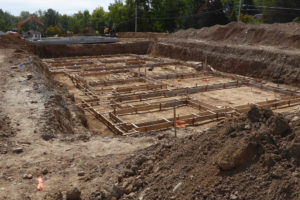
Many potential clients I meet with discuss their desire for an addition and in their minds, they always seem to think they will save some money by creating a crawl space under the addition. When we walk around the property it seems that about 80% of the time the rear yard slopes downward and is usually greater than three feet below the existing finished floor. Why would that matter? Well, it matters because in North Jersey the required depth for the bottom of a footing is 42”. The footing is at the base of your foundation wall and is typically a widened portion at the bottom of the wall that transfers the load over a wider area helping to avoid settling. So, in reality, the foundation wall of your addition needs to be at approximately the same level as your existing basement! So for a few more shekels, you can get yourself a nice area for additional storage or future living space. Depending on how much your property slopes could end up determining how to use this unpredicted additional space.
Why does the footing need to be so deep? It helps to prevent heaving caused by ice lensing. Most people are familiar with this phenomenon as frost heave. In the winter the soil gets very cold and frozen closer to the surface. Water is drawn from the unfrozen soil below as it is drawn upward the water turns into layers of ice which in turn force the soil particles to separate as it pushes upward. This ultimately pushes up your footing if it is not deep enough and wreaks havoc on your home. That is some strong ice! It could cause cracking in your foundation wall, as well as crack windows and pipes. So if you have your footing deep enough are you safe from ice lensing? One would think so but actually one would be wrong! Ice lensing can also occur adjacent to your foundation wall. This is known as adfreezing and can be as harmful to the foundation wall as a misplaced footing. This can be avoided also by placing a well draining granular backfill.
Three key elements must be present for adfreezing and ice lensing to occur;
- The soil adjacent to the foundation is vulnerable to frost such as a soil with heavy concentrates in silt and clay
- Water needs to be present in the earth adjacent to the structure
- Freeze thaw cycling adjacent to the structure.
All three elements must be present for this problem to occur.
So if you are considering that addition, a basement might sound like a great idea!


